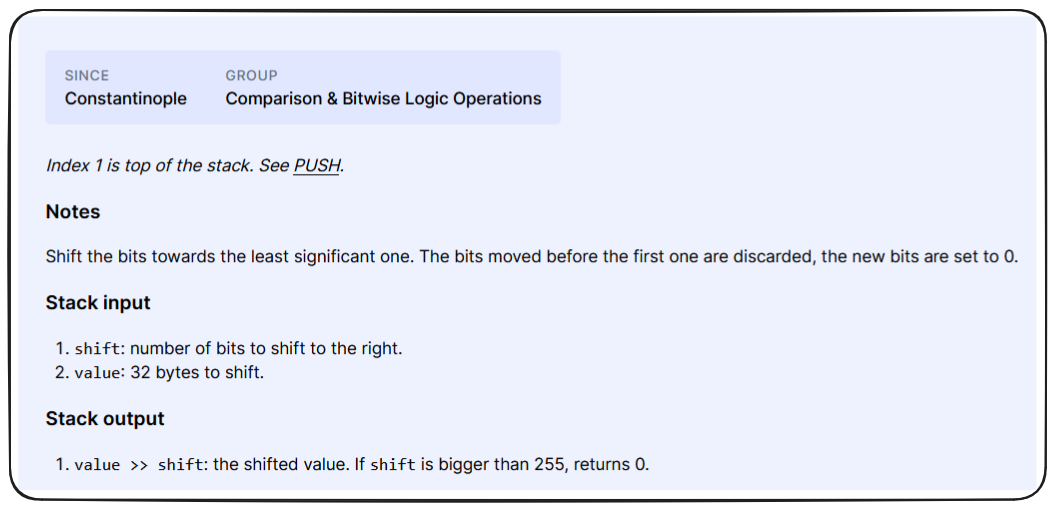5/5
_Follow along with this video:_ --- The next part can be a little tough to grasp at first, and that's ok. Take your time and work through a few examples to really help this stick. ### Slicing Bits Our ultimate goal is to access the `function selector` of the `calldata` sent to our contract. This is represented by the first 8 bytes of our `calldata`. ``` 0xe026c0170000000000000000000000000000000000000000000000000000000000000001 ``` In order to achieve this, there's an opcode we can use! 😲 In [**evm.codes**](https://www.evm.codes/?fork=shanghai) search for `shr`. This stands for `Shift Right` and is precisely the tool we need.  In order to use this opcode, we need 2 items on the stack - shift: number of bits to shift to the right - value: 32 bytes to shift Let's look at a simple example! Consider below: ``` 0x0102 (2 bytes) 1 byte = 8 bits ``` It's important to remember that the `shr` opcode is how many _bits_ we're shifting to the right, _not bytes_. This means we can rewrite our hex in binary to see it's bits representation. We can use the command `cast --to-base 0x0102 bin` to have the binary output for us. ``` 0b100000010 ``` In the above `1` represents `01` and `00000010` represents `02`. > **Note:** It may seem like we're only having 9 bits returned to us, but the value of `1` is being truncated. `1` in this circumstance is equivalent to `00000001` So, let's say we want to `shr` 2 bits from our value of `0b100000010`. This is going to remove the two right most digits and shift everything else to the right. Our output should be `0b001000000` We can then use Foundry once more to see what this value would be in hex: ``` cast --to-base 0b001000000 hex ``` The output we receive is `0x40`! I encourage you to test this out further yourself. Try shifting a variety of decimal places and experiment with how this affects your output.
Follow along with this video:
The next part can be a little tough to grasp at first, and that's ok. Take your time and work through a few examples to really help this stick.
Slicing Bits
Our ultimate goal is to access the function selector of the calldata sent to our contract. This is represented by the first 8 bytes of our calldata.
In order to achieve this, there's an opcode we can use! 😲
In evm.codes search for shr. This stands for Shift Right and is precisely the tool we need.

In order to use this opcode, we need 2 items on the stack
shift: number of bits to shift to the right
value: 32 bytes to shift
Let's look at a simple example!
Consider below:
It's important to remember that the shr opcode is how many bits we're shifting to the right, not bytes.
This means we can rewrite our hex in binary to see it's bits representation. We can use the command cast --to-base 0x0102 bin to have the binary output for us.
In the above 1 represents 01 and 00000010 represents 02.
Note: It may seem like we're only having 9 bits returned to us, but the value of
1is being truncated.1in this circumstance is equivalent to00000001
So, let's say we want to shr 2 bits from our value of 0b100000010. This is going to remove the two right most digits and shift everything else to the right. Our output should be 0b001000000
We can then use Foundry once more to see what this value would be in hex:
The output we receive is 0x40!
I encourage you to test this out further yourself. Try shifting a variety of decimal places and experiment with how this affects your output.
SHR
A practical guide to understanding Right Shift in Solidity - This lesson explains how the SHR opcode works and how it can be used to easily extract the function selector from the calldata. It shows you how to represent numbers in binary, hex, and decimal and uses these representations to demonstrate the effect of the SHR opcode on calldata.
Previous lesson
Previous
Next lesson
Next
Give us feedback
Course Overview
About the course
What you'll learn
Assembly
Writing smart contracts using Huff and Yul
Ethereum Virtual Machine OPCodes
Formal verification testing
Smart contract invariant testing
Halmos, Certora, Kontrol
Course Description
Who is this course for?
- Smart contract security researchers
- Advanced Smart contract engineers
- Chief Security Officiers
- Security professionals
Potential Careers
Security researcher
$49,999 - $120,000 (avg. salary)
Smart Contract Auditor
$100,000 - $200,000 (avg. salary)
Meet your instructors
Guest lecturers:
Last updated on August 11, 2025
Duration: 30min
Duration: 4h 38min
Duration: 3h 57min
Duration: 1h 56min
Course Overview
About the course
What you'll learn
Assembly
Writing smart contracts using Huff and Yul
Ethereum Virtual Machine OPCodes
Formal verification testing
Smart contract invariant testing
Halmos, Certora, Kontrol
Course Description
Who is this course for?
- Smart contract security researchers
- Advanced Smart contract engineers
- Chief Security Officiers
- Security professionals
Potential Careers
Security researcher
$49,999 - $120,000 (avg. salary)
Smart Contract Auditor
$100,000 - $200,000 (avg. salary)
Meet your instructors
Guest lecturers:
Last updated on August 11, 2025
